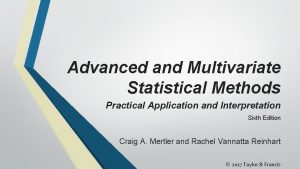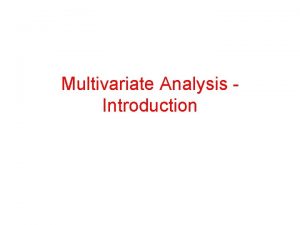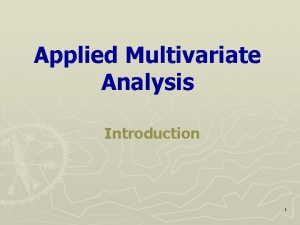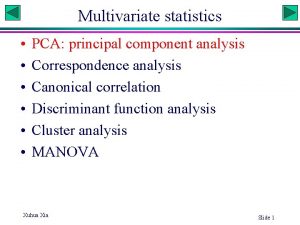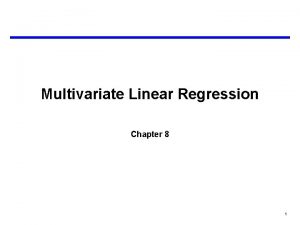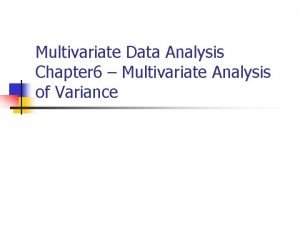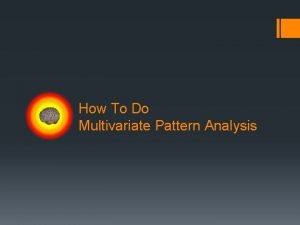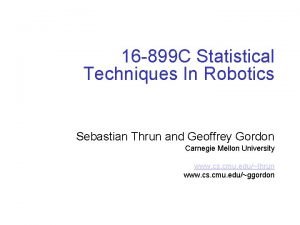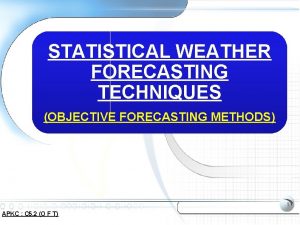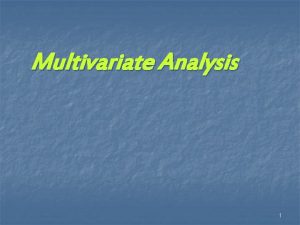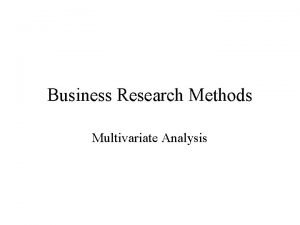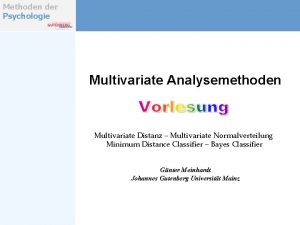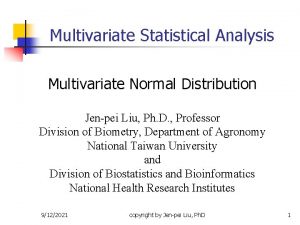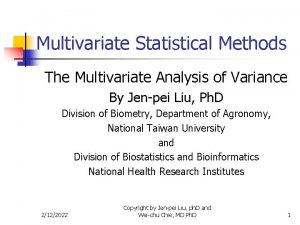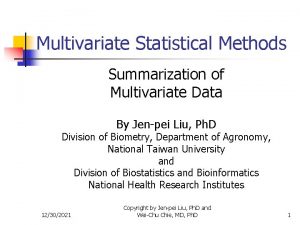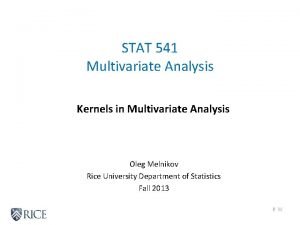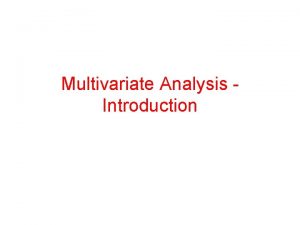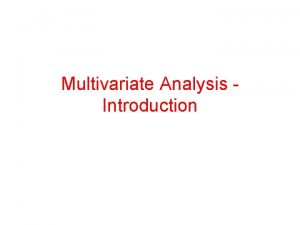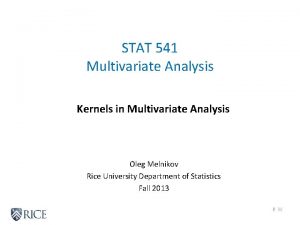Multivariate Analysis Techniques Multivariate Analysis Techniques All statistical













- Slides: 13

Multivariate Analysis Techniques

Multivariate Analysis Techniques • All statistical techniques which simultaneously analyse more than two variables on a sample of observations can be categorized as multivariate techniques • Most of the research studies involve more than two variables in which situation analysis is desired of the association between one (at times many) criterion variable and several independent variables, or we may be required to study the association between variables having no dependency relationships • In brief, techniques that take account of the various relationships among variables are termed multivariate analyses or multivariate techniques.


Multiple Regression • In multiple regression we form a linear composite of explanatory variables in such way that it has maximum correlation with a criterion variable • The main objective in using this technique is to predict the variability the dependent variable based on its covariance with all the independent variables • One can predict the level of the dependent phenomenon through multiple regression analysis model, given the levels of independent variables. • Step-wise regression techniques

Multiple Discriminant Analysis • Through discriminant analysis technique, researcher may classify individuals or objects into one of two or more mutually exclusive and exhaustive groups on the basis of a set of independent variables • Brand preference (say brand x or y) is the dependent variable of interest and its relationship to an individual’s income, age, education, etc. is being investigated, then we should use the technique of discriminant analysis • Discriminant analysis is considered an appropriate technique when the single dependent variable happens to be non-metric and is to be classified into two or more groups, depending upon its relationship with several independent variables which all happen to be metric

Multivariate analysis of variance • Multivariate analysis of variance is an extension of bivariate analysis of variance in which the ratio of among-groups variance to within-groups variance is calculated on a set of variables instead of a single variable. • This technique is considered appropriate when several metric dependent variables are involved in a research study along with many non-metric explanatory variables • In other words, multivariate analysis of variance is specially applied whenever the researcher wants to test hypotheses concerning multivariate differences in group responses to experimental manipulations. • For instance, the market researcher may be interested in using one test market and one control market to examine the effect of an advertising campaign on sales as well as awareness, knowledge and attitudes. In that case he should use the technique of multivariate analysis of variance for meeting his objective.

Canonical Correlation Analysis • The main objective of canonical correlation analysis is to discover factors separately in the two sets of variables such that the multiple correlation between sets of factors will be the maximum possible.

Factor analysis • Factor analysis is by far the most often used multivariate technique of research studies, specially pertaining to social and behavioural sciences • It is a technique applicable when there is a systematic interdependence among a set of observed or manifest variables and the researcher is interested in finding out something more fundamental or latent which creates this commonality • Factor analysis, thus, seeks to resolve a large set of measured variables in terms of relatively few categories, known as factors. This technique allows the researcher to group variables into factors (based on correlation between variables) and the factors so derived may be treated as new variables (often termed as latent variables)

Cluster Analysis • Cluster analysis consists of methods of classifying variables into clusters. • Technically, a cluster consists of variables that correlate highly with one another and have comparatively low correlations with variables in other clusters • The basic objective of cluster analysis is to determine how many mutually and exhaustive groups or clusters, based on the similarities of profiles among entities, really exist in the population and then to state the composition of such groups.

Multidimensional Scaling • Multidimensional scaling (MDS) allows a researcher to measure an item in more than one dimension at a time. • The basic assumption is that people perceive a set of objects as being more or less similar to one another on a number of dimensions (usually uncorrelated with one another) instead of only one • With MDS, one can scale objects, individuals or both with a minimum of information. The MDS analysis will reveal the most salient attributes which happen to be the primary determinants for making a specific decision.

Latent Structure Analysis • This type of analysis shares both of the objectives of factor analysis viz. , to extract latent factors and express relationship of observed (manifest) variables with these factors as their indicators and to classify a population of respondents into pure types. • This type of analysis is appropriate when the variables involved in a study do not possess dependency relationship and happen to be non-metric.


 Multivariate statistical analysis
Multivariate statistical analysis Advanced and multivariate statistical methods
Advanced and multivariate statistical methods What is multivariate analysis?
What is multivariate analysis? Multi variance
Multi variance Nature of multivariate analysis
Nature of multivariate analysis Multivariate analysis of variance and covariance
Multivariate analysis of variance and covariance Multivariate analysis
Multivariate analysis Multivariate analysis
Multivariate analysis Multivariate analysis
Multivariate analysis Multivariate pattern analysis
Multivariate pattern analysis Name 3 points
Name 3 points Statistical techniques in robotics
Statistical techniques in robotics Weather forecasting techniques
Weather forecasting techniques Alex teichman
Alex teichman

